In today's automotive landscape, electric vehicles (EVs) are at the forefront of innovation, with numerous manufacturers vying for the attention of environmentally conscious consumers. Among the noteworthy entrants in this segment are the Renault R5 and the Hyundai Inster. This article delves into a comparative analysis of these two electric vehicles, focusing on their technical specifications, innovations, and overall performance in the rapidly evolving market.
Renault R5 vs Hyundai Inster – Which one offers the better deal?
Two cars, one duel: Renault R5 meets Hyundai Inster.
Which one wins in performance, efficiency and value for money? Find out now!
Design and Dimensions
The Renault R5, a hatchback, boasts a compact design with a length of 3922 mm, width of 1744 mm, and height of 1498 mm. This makes it a suitable choice for urban environments, where maneuverability is key. In contrast, the Hyundai Inster takes on the SUV form factor, measuring between 3825 mm and 3845 mm in length, 1610 mm in width, and a height ranging from 1575 mm to 1610 mm. This gives the Inster a more commanding road presence and extra cabin height, beneficial for passenger comfort.
Engine and Performance
Both models are powered by electric motors, but their performance outputs differ. The Renault R5 offers a range of power options from 95 HP to 150 HP, with an impressive torque output of up to 245 Nm. The vehicle accelerates from 0-100 km/h in as little as 8 seconds, making it sprightly for city driving.
The Hyundai Inster, on the other hand, provides two power variants of 97 HP and 115 HP, with a torque of 147 Nm. Its acceleration is slower compared to the R5, taking up to 11.7 seconds to reach the same speed. While the Inster's performance may not match the R5, its top speed can reach 150 km/h, similar to the R5, demonstrating that both cars are capable of highway speeds.
Battery and Range
Range anxiety is a common concern among EV owners, and here the Renault R5 shines. It offers an electric range between 300 km and 405 km, depending on configuration. This is facilitated by a battery capacity of 40 kWh, allowing for efficient energy consumption of 14.8 kWh/100 km.
The Hyundai Inster presents a competitive offering with its electric range spanning from 327 km to 370 km, supported by a larger battery capacity that goes up to 49 kWh. However, its energy consumption is slightly higher, with estimates ranging from 14.3 kWh to 15.1 kWh/100 km, potentially affecting long-distance journeys.
Interior and Capacity
When it comes to seating, the Renault R5 accommodates five passengers comfortably. Its interior focuses on utility with a trunk capacity of 326 liters. The Hyundai Inster seats four, and the trunk capacity varies between 238 liters and 280 liters, suitable for short trips and daily commuting but may limit cargo space for longer adventures.
Innovation and Technology
Each model incorporates modern technological features aimed at enhancing the driving experience. The Renault R5 emphasizes a user-friendly interface that integrates smart connectivity options, while the Hyundai Inster focuses on a fusion of safety technology and driver assist features, ensuring a secure and enjoyable ride.
Conclusion
In conclusion, the Renault R5 and Hyundai Inster each present compelling cases for those interested in electric mobility. The R5 stands out with its impressive range, power options, and spirited performance, while the Inster appeals to those looking for the SUV experience, combining practicality with advanced technology. Ultimately, the choice between these models will depend on personal preferences regarding space, performance, and intended use.
Here’s where it gets real: The technical differences in detail
Costs and Efficiency:
Price and efficiency are often the first things buyers look at. Here it becomes clear which model has the long-term edge – whether at the pump, the plug, or in purchase price.
Hyundai Inster has a slightly advantage in terms of price – it starts at 20500 £, while the Renault R5 costs 23900 £. That’s a price difference of around 3429 £.
In terms of energy consumption, the advantage goes to the Hyundai Inster: with 14.30 kWh per 100 km, it’s minimal more efficient than the Renault R5 with 14.80 kWh. That’s a difference of about 0.50 kWh.
As for range, the Renault R5 performs barely noticeable better – achieving up to 405 km, about 35 km more than the Hyundai Inster.
Engine and Performance:
Power, torque and acceleration are the classic benchmarks for car enthusiasts – and here, some clear differences start to show.
When it comes to engine power, the Renault R5 has a significantly edge – offering 540 HP compared to 115 HP. That’s roughly 425 HP more horsepower.
In acceleration from 0 to 100 km/h, the Renault R5 is decisively quicker – completing the sprint in 3.50 s, while the Hyundai Inster takes 10.60 s. That’s about 7.10 s faster.
In terms of top speed, the Renault R5 performs clearly better – reaching 270 km/h, while the Hyundai Inster tops out at 150 km/h. The difference is around 120 km/h.
There’s also a difference in torque: Renault R5 pulls decisively stronger with 4800 Nm compared to 147 Nm. That’s about 4653 Nm difference.
Space and Everyday Use:
Cabin size, boot volume and payload all play a role in everyday practicality. Here, comfort and flexibility make the difference.
Seats: Renault R5 offers somewhat more seating capacity – 5 vs 4.
In curb weight, Hyundai Inster is barely noticeable lighter – 1380 kg compared to 1447 kg. The difference is around 67 kg.
In terms of boot space, the Renault R5 offers somewhat more room – 326 L compared to 280 L. That’s a difference of about 46 L.
In maximum load capacity, the Renault R5 performs minimal better – up to 1106 L, which is about 47 L more than the Hyundai Inster.
When it comes to payload, Renault R5 to a small extent takes the win – 418 kg compared to 357 kg. That’s a difference of about 61 kg.
Who comes out on top?
Overall, the Renault R5 shows itself to be is largely superior and secures the title of DriveDuel Champion.
It convinces with the more balanced overall package and proves to be the more versatile choice for everyday use.
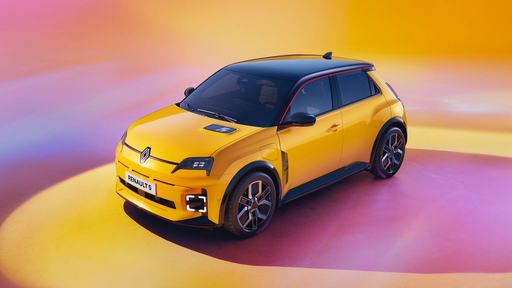 @ Renault Group Media
@ Renault Group Media
Renault R5
Renault R5
The Renault 5 is a cheeky city car that marries retro charm with modern flair, its playful looks promising smiles before you even start the engine. Practical enough for daily life yet lively enough to make short trips feel like mini adventures, it’s an irresistible choice for buyers who prefer personality to bland practicality.
details @ Renault Group Media
@ Renault Group Media
 @ Renault Group Media
@ Renault Group Media
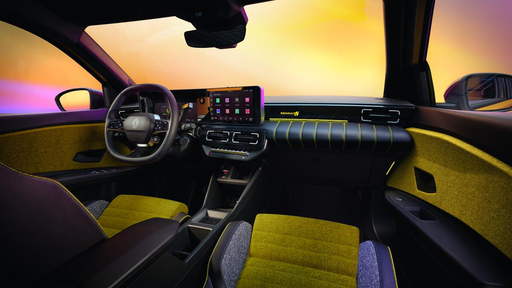 @ Renault Group Media
@ Renault Group Media
Hyundai Inster
The Inster has quickly captured the attention of automotive enthusiasts with its striking design and dynamic performance. This model seamlessly blends advanced technology with comfort, making it an ideal choice for both daily commutes and adventurous road trips. With its spacious interior and innovative features, the Inster promises an exhilarating driving experience that doesn’t compromise on practicality.
details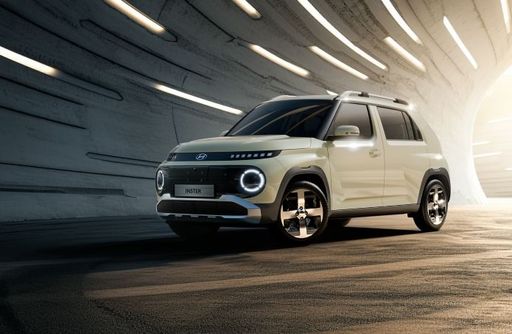 @ Hyundai Motor Company
@ Hyundai Motor Company
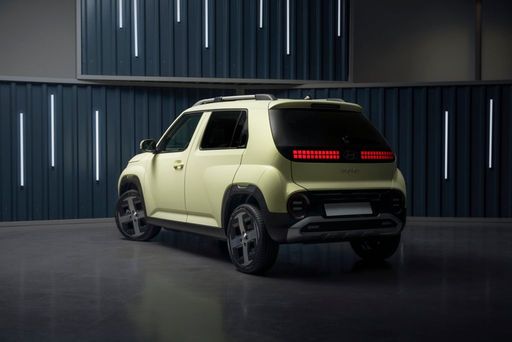 @ Hyundai Motor Company
@ Hyundai Motor Company
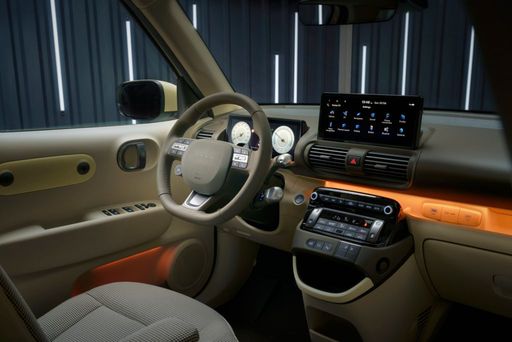 @ Hyundai Motor Company
@ Hyundai Motor Company
 @ Renault Group Media
@ Renault Group Media
|
 @ Hyundai Motor Company
@ Hyundai Motor Company
|
|
|
|
Costs and Consumption |
|
|---|---|
|
Price
23900 - 137100 £
|
Price
20500 - 25800 £
|
|
Consumption L/100km
-
|
Consumption L/100km
-
|
|
Consumption kWh/100km
14.8 - 15.2 kWh
|
Consumption kWh/100km
14.3 - 15.1 kWh
|
|
Electric Range
307 - 405 km
|
Electric Range
327 - 370 km
|
|
Battery Capacity
40 - 52 kWh
|
Battery Capacity
42 - 49 kWh
|
|
co2
0 g/km
|
co2
0 g/km
|
|
Fuel tank capacity
-
|
Fuel tank capacity
-
|
Dimensions and Body |
|
|---|---|
|
Body Type
Hatchback
|
Body Type
SUV
|
|
Seats
2 - 5
|
Seats
4
|
|
Doors
3 - 5
|
Doors
5
|
|
Curb weight
1447 - 1524 kg
|
Curb weight
1380 - 1433 kg
|
|
Trunk capacity
326 L
|
Trunk capacity
238 - 280 L
|
|
Length
3922 - 4080 mm
|
Length
3825 - 3845 mm
|
|
Width
1744 - 2030 mm
|
Width
1610 mm
|
|
Height
1380 - 1498 mm
|
Height
1575 - 1610 mm
|
|
Max trunk capacity
1106 L
|
Max trunk capacity
1059 L
|
|
Payload
396 - 418 kg
|
Payload
317 - 357 kg
|
Engine and Performance |
|
|---|---|
|
Engine Type
Electric
|
Engine Type
Electric
|
|
Transmission
Automatic
|
Transmission
Automatic
|
|
Transmission Detail
Reduction Gearbox
|
Transmission Detail
Reduction Gearbox
|
|
Drive Type
Front-Wheel Drive, Rear-Wheel Drive
|
Drive Type
Front-Wheel Drive
|
|
Power HP
122 - 540 HP
|
Power HP
97 - 115 HP
|
|
Acceleration 0-100km/h
3.5 - 9 s
|
Acceleration 0-100km/h
10.6 - 11.7 s
|
|
Max Speed
150 - 270 km/h
|
Max Speed
140 - 150 km/h
|
|
Torque
225 - 4800 Nm
|
Torque
147 Nm
|
|
Number of Cylinders
-
|
Number of Cylinders
-
|
|
Power kW
90 - 397 kW
|
Power kW
71 - 85 kW
|
|
Engine capacity
-
|
Engine capacity
-
|
General |
|
|---|---|
|
Model Year
2025 - 2027
|
Model Year
2025
|
|
CO2 Efficiency Class
A
|
CO2 Efficiency Class
A
|
|
Brand
Renault
|
Brand
Hyundai
|
What drive types are available for the Renault R5?
The Renault R5 is available as Front-Wheel Drive or Rear-Wheel Drive.
The prices and data displayed are estimates based on German list prices and may vary by country. This information is not legally binding.
